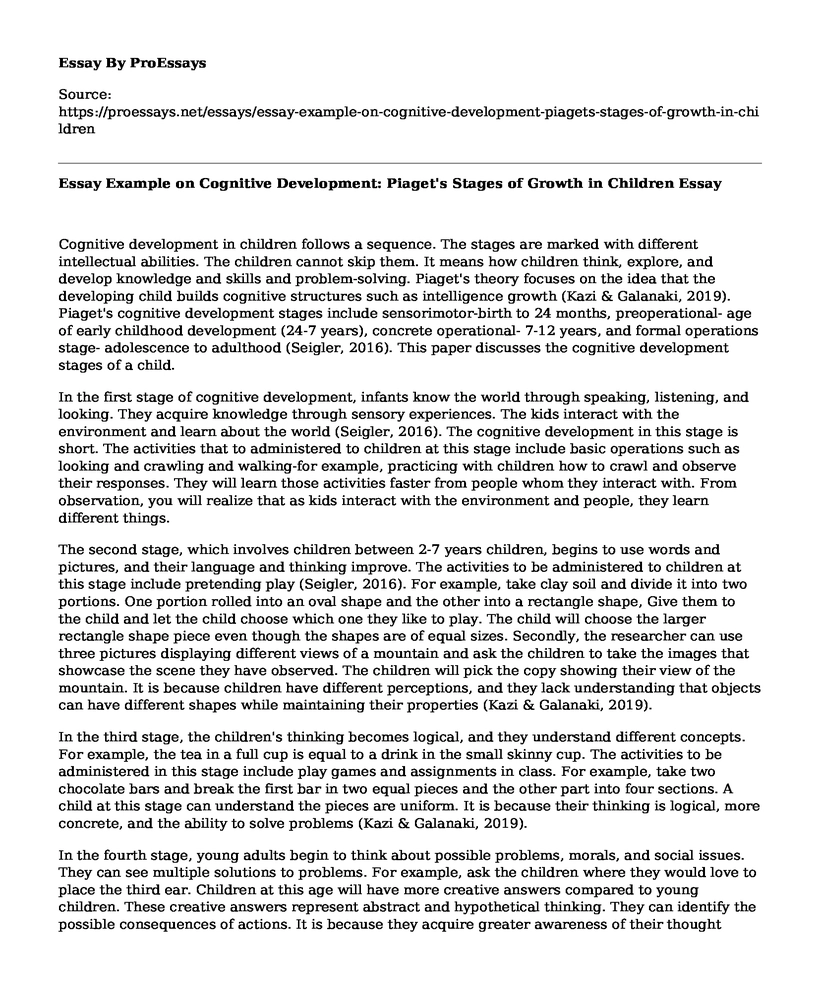Cognitive development in children follows a sequence. The stages are marked with different intellectual abilities. The children cannot skip them. It means how children think, explore, and develop knowledge and skills and problem-solving. Piaget's theory focuses on the idea that the developing child builds cognitive structures such as intelligence growth (Kazi & Galanaki, 2019). Piaget's cognitive development stages include sensorimotor-birth to 24 months, preoperational- age of early childhood development (24-7 years), concrete operational- 7-12 years, and formal operations stage- adolescence to adulthood (Seigler, 2016). This paper discusses the cognitive development stages of a child.
In the first stage of cognitive development, infants know the world through speaking, listening, and looking. They acquire knowledge through sensory experiences. The kids interact with the environment and learn about the world (Seigler, 2016). The cognitive development in this stage is short. The activities that to administered to children at this stage include basic operations such as looking and crawling and walking-for example, practicing with children how to crawl and observe their responses. They will learn those activities faster from people whom they interact with. From observation, you will realize that as kids interact with the environment and people, they learn different things.
The second stage, which involves children between 2-7 years children, begins to use words and pictures, and their language and thinking improve. The activities to be administered to children at this stage include pretending play (Seigler, 2016). For example, take clay soil and divide it into two portions. One portion rolled into an oval shape and the other into a rectangle shape, Give them to the child and let the child choose which one they like to play. The child will choose the larger rectangle shape piece even though the shapes are of equal sizes. Secondly, the researcher can use three pictures displaying different views of a mountain and ask the children to take the images that showcase the scene they have observed. The children will pick the copy showing their view of the mountain. It is because children have different perceptions, and they lack understanding that objects can have different shapes while maintaining their properties (Kazi & Galanaki, 2019).
In the third stage, the children's thinking becomes logical, and they understand different concepts. For example, the tea in a full cup is equal to a drink in the small skinny cup. The activities to be administered in this stage include play games and assignments in class. For example, take two chocolate bars and break the first bar in two equal pieces and the other part into four sections. A child at this stage can understand the pieces are uniform. It is because their thinking is logical, more concrete, and the ability to solve problems (Kazi & Galanaki, 2019).
In the fourth stage, young adults begin to think about possible problems, morals, and social issues. They can see multiple solutions to problems. For example, ask the children where they would love to place the third ear. Children at this age will have more creative answers compared to young children. These creative answers represent abstract and hypothetical thinking. They can identify the possible consequences of actions. It is because they acquire greater awareness of their thought process (Seigler, 2016).
Conclusion
In conclusion, cognitive stages of development involve several steps. They include sensorimotor, preoperational, concrete operational, and formal operational phases. The children think and solve problems differently in every stage. It is because of intellectual growth and their knowledge and skills at that stage. The activities administered to children imply that they acquire knowledge, skills, and ability to solve problems as they grow older.
References
Kazi, S., & Galanaki, E. (2019). Piagetian Theory of Cognitive Development. The Encyclopedia of Child and Adolescent Development, 1-11. https://onlinelibrary.wiley.com/doi/abs/10.1002/9781119171492.wecad364
Siegler, R. S. (2016). Continuity and change in the field of cognitive development and the perspectives of one cognitive-developmental. Child Development Perspectives, 10(2), 128-133. https://srcd.onlinelibrary.wiley.com/doi/abs/10.1111/cdep.12173
Cite this page
Essay Example on Cognitive Development: Piaget's Stages of Growth in Children. (2023, Apr 09). Retrieved from https://proessays.net/essays/essay-example-on-cognitive-development-piagets-stages-of-growth-in-children
If you are the original author of this essay and no longer wish to have it published on the ProEssays website, please click below to request its removal:
- Paper Example on Childhood Trauma
- Essay Sample on Schools as Organizations: Formal and Informal Education
- Private vs. Public Schools Essay Example
- Treatment of Women Veterans With PTSD Paper Example
- Essay Sample on Leading Personality Theorist: Alfred Adler
- Research Paper on Learn Change Through Systems Think: Peter Senge's 5 Disciplines
- Essay Example on Becoming a Family Nurse Practitioner: My Journey to Serve







